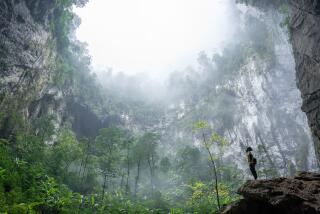DAVID ATTENBOROUGH: Dig Those Dinosaurs
- Share via
Naturalist Sir David Attenborough goes looking for dinosaurs in his latest documentary “Lost Worlds, Vanished Lives,” premiering tonight on TBS.
The three-hour special follows Attenborough’s expeditions from the English quarries to dinosaur digs in Montana and Africa.
Attenborough, the brother of Oscar-winning actor-director Sir Richard Attenborough, had been involved in broadcasting for 38 years. He’s best known in America for his award-winning series “Life on Earth” and “The Living Planet.” He was knighted for his work on conservation in 1985.
Attenborough talked about his latest documentary with Susan King.
Did you love dinosaurs when you were a child?
As a kid, I collected fossils and acquired a passion for fossils and a delight and an amazement of fossils which I never got rid. What fascinated me about fossils is when you collect them you can see a hunk of rock and you can hit it in the right place, if you know where the right place is, and it will fall open and you may then see a most beautiful organism that hasn’t seen the sunlight for 400 million years. That’s kind of magic.
Where did you travel in the United States in your search for dinosaurs for the documentary?
We went to Montana in order to look at dinosaurs and nests of dinosaur eggs.
Where in Montana?
I am afraid I am not allowed to reveal that (laughs). It’s a state secret. A wonderful chap called Jack Horner, who is the geologist and paleontologist in Bozeman, discovered them. There was a lake which has long disappeared, but those nest sights remain (near the lake). In fact, they have excavated many of them. You find about a dozen or so eggs still in place. When you take some of them and X-ray them, you can see that the little baby dinosaurs are still in there with its little arms around its head and its tail wrapped around. Jack has very carefully dissected them and got out the bones and little skulls and jaws. It is breathtaking stuff.
What else did you find in the U.S.?
We went to lots of places. We went to some of the marvelous sights where there are dinosaur footprints. There are huge areas where if you go up in the helicopters you can see deep imprints of feet and you can see sometimes where there are two or three adults and behind them a little one with its feet only half the size.
We went down to Texas to the Big Bend, which is down south near the Mexican border, and that was where they found these enormous pterodactyl which had wing spans of 60 feet. And then you can get those bones out, you can set them up and see exactly how from the joints on them they fit together--so you can tell exactly how the animal beat its wings, and from that you can calculate where the muscles must have gone. From there, you can take it to some of the super clever engineers and get them to build one and to build nearly a full size one which will flap its wings and take off and fly off through the night sky.
Were dinosaurs particularly smart animals?
Dinosaurs were pretty bright. It is a slander on dinosaurs to say that they were stupid, great lumbering animals with brains in their tales. The fact is that dinosaurs dominated the world for much longer than human beings have. I mean, everybody talks about how dinosaurs died out, but dinosaurs were in power for several hundred million years and human beings haven’t been on the Earth for 10 million years yet.
The other thing is that dinosaurs were extraordinarily varied, as varied as mammals are. With mammals you have mice, bats, human beings and elephants. And you had dinosaurs that were no bigger than chickens, you had dinosaurs that were far bigger than an elephant. You had vegetarian dinosaurs and carnivores and hunting dinosaurs and swamp-living dinosaurs.
Did the scientists come across any new dinosaurs during the production of the documentary?
You are finding them all the time. Our knowledge of dinosaurs is still very marginal. They were only discovered over just 100 years ago.
We didn’t discover any new ones. But finding a new dinosaur is not difficult. New dinosaurs are being discovered every year and new names are being coined for them. And then (after finding a dinosaur) you have quite a long scientific debate. Is it really a new dinosaur or is it perhaps a female of one we already know from a male form? Or is it a juvenile? There are very complicated technical questions.
Your new book “The Trials of Life,” was recently published. When is the documentary series based on the book going to air?
Ted Turner has bought the 12 one-hour programs and they are going out (on TBS) on June 2. The series explores the ways animals solve the various problems they face. It starts off with the problems of getting born and arriving in the world, of growing up, finding food, communicating and getting along with their neighbors, finding a mate and courtship.
Do you have any idea what the subject will be of your next documentary?
My wife has planned a holiday. I haven’t had a holiday for the last 14 years. But a lot of people say my life is one long holiday.
“Lost Worlds, Vanished Lives” premieres tonight at 5 p.m. and repeats Monday at 8:15 p.m. on TBS.
More to Read
Sign up for The Wild
We’ll help you find the best places to hike, bike and run, as well as the perfect silent spots for meditation and yoga.
You may occasionally receive promotional content from the Los Angeles Times.







